Smarter Electric Vehicle Infrastructure Starts with Smarter Data
Key Takeaways
- Static planning has led to underused EV chargers and service gaps; real-time mobility data ensures chargers are placed where drivers actually travel and stop.
- Using origin-destination, dwell-time, and freight data enables planners to tailor charger types, optimize fleet operations, and predict site revenue.
- Data-driven planning reduces waste, improves utilization, and builds scalable, equitable EV infrastructure ready for future mobility demands.
By Michael Cottle, Contributing Author
As electric vehicle (EV) adoption continues to grow across the globe, the challenge of delivering reliable and accessible charging infrastructure is becoming more critical and complex. Too often, charger deployment is guided by static models or without the benefit of up-to-date data to inform these decisions. This has led to disparities between station location and actual demand.
The result: underused stations in low-traffic zones, persistent gaps in rural and underserved communities, and missed opportunities to support commercial fleets efficiently.
The Limits of Traditional Planning
Historically, charging infrastructure has been deployed using conventional planning inputs, including population density, land availability or proximity to major roads. These inputs are relatively easy to access, straightforward to use, and are definitely part of the formula. But they don’t reflect how people and goods move. This has often led to “white elephant” charging locations, or stations that see little usage. With federal funding tightening, smarter, data-informed decisions are essential to ensure the long-term success of EV charger placements.
To close this gap, transportation planners and EV charging operators must shift from static models to dynamic, data-driven infrastructure planning. The key to this is leveraging mobility data to understand where and how EVs are traveling, stopping, and needing to charge. This approach improves efficiency and supports a more equitable, scalable, and future-ready charging network.
Rethinking Charger Deployment with Real-Time Insights
Decisions about where to place chargers, how many are needed, and what type to install depend on more than population counts. Effective planning requires understanding real trip behavior: the routes vehicles take, where they dwell and the corridors with the highest traffic volume.
Real-time mobility data helps to guide this planning, including:
- Identifying High-Demand Corridors: Transportation road volume data highlights the road segments with the most traffic, helping planners target installation on urban highways, key freight routes and commuter corridors. These insights enable infrastructure that aligns with actual usage rather than hypothetical models.
- Pinpointing Trip Endpoints: Origin-destination data can map where vehicles begin and end their journeys, from retail centers and office parks to truck depots, so planners can place chargers where EVs already stop. This is especially important for fleets, which rely on precise dwell time and route-based planning to keep operations moving.
- Optimizing Commercial Charging: Real-time parking and dwell-time data reveal where commercial EVs naturally pause, supporting efficient charger placement. Aligning charger type and power level with vehicle class, dwell duration and peak usage patterns ensures reliable access for route-based fleets.
- Tailoring Charger Types to Road Behavior: Understanding travel speed variability helps determine where fast chargers are needed (high-speed corridors) versus where slower, longer dwell-time chargers make sense (urban centers or parking facilities).
- Predicting Revenue: By understanding usage and revenue at existing locations that exhibit the same volume of vehicle traffic, EV charging operators can predict the revenue potential of new sites.
A Roadmap for Smarter EV Infrastructure
To effectively transition from static to dynamic EV infrastructure planning, several key strategies should be prioritized:
- Use Real-World Data to Guide Siting Decisions: Leverage origin-destination analytics, volume profiles, and dwell time to understand where vehicles move and stop. Prioritize routes and locations with demonstrable demand.
- Integrate Fleet and Freight Considerations Early: Commercial EVs have different charging needs. Use freight-specific data, like truck parking patterns and depot usage, to guide siting for medium- and heavy-duty infrastructure.
- Plan for the Present and the Future: Mobility data can forecast future usage by analyzing long-term speed profiles, congestion trends, and route evolution. This ensures that today’s infrastructure doesn’t become tomorrow’s bottleneck.
The Impact: Smarter, Scalable EV Infrastructure
When EV charger deployment is guided by real-world mobility patterns, the benefits extend across the entire transportation ecosystem:
- Higher Utilization: Chargers are installed where demand is proven, not assumed.
- Less Waste: Reduces underused locations and improves return on infrastructure investment.
- Greater Adaptability: Real-time data supports dynamic planning as travel behavior shifts.
- Faster Adoption: A more reliable, accessible charging network builds driver trust and reduces range anxiety.
- Fleet Readiness: Commercial operators get the infrastructure needed to expand EV deployment at scale.
These meaningful outcomes are possible when infrastructure decisions reflect real movement patterns, not just maps and models.
Looking Ahead
The decisions being made now about EV charger placement, capacity, and accessibility will shape mobility for decades. Static planning models are too rigid to keep up with the dynamic nature of modern transportation. With near real-time mobility intelligence, infrastructure can evolve from reactive to responsive, unlocking smarter EV networks that are efficient, equitable, and ready for the future.
Michael Cottle is the SVP for INRIX Enterprise. For more than 25 years, Michael has built successful software businesses, working with OEMs and Tier One partners around the world.
